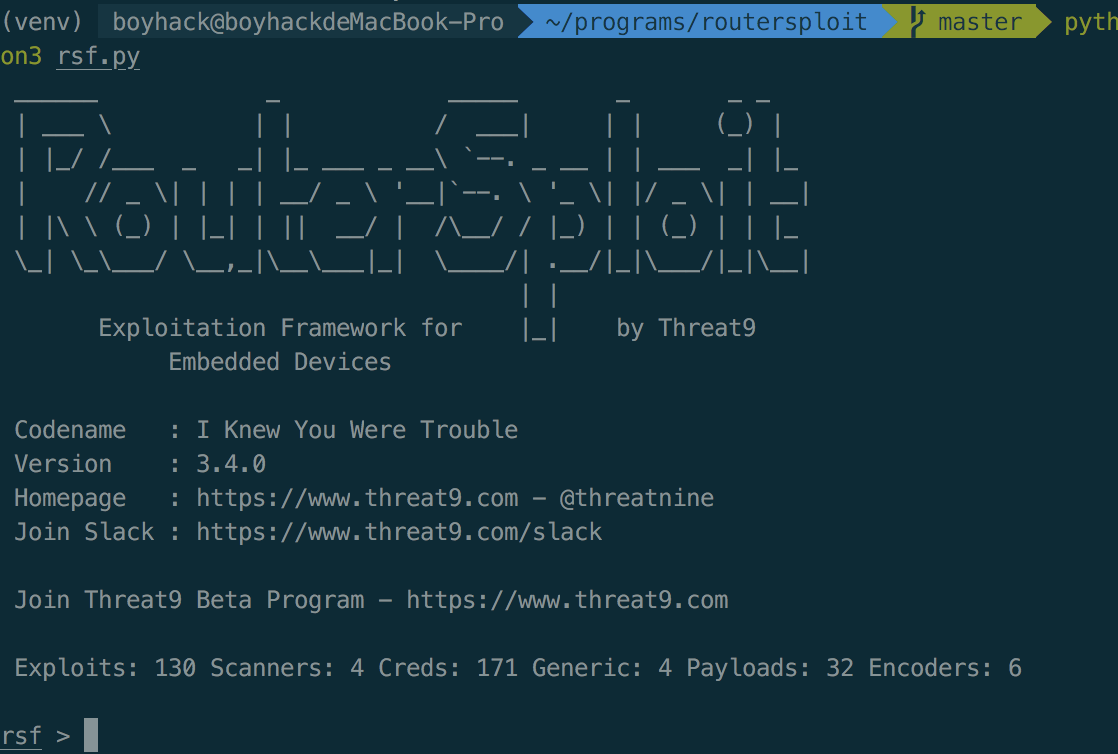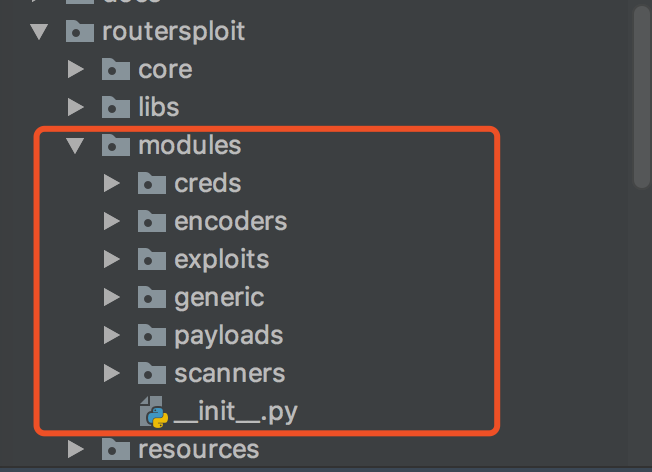routersploit 源码分析
RouteSploit框架是一款开源的漏洞检测及利用框架,其针对的对象主要为路由器等嵌入式设备。
具体介绍可以看:https://www.freebuf.com/sectool/101441.html
routersploit的操作模式有点类似于msf,想看看是如何实现的
Print
屏幕打印最后都定位到了这个函数
def __cprint(*args, **kwargs):
""" Color print()
Signature like Python 3 print() function
print([object, ...][, sep=' '][, end='\n'][, file=sys.stdout])
"""
if not kwargs.pop("verbose", True):
return
sep = kwargs.get("sep", " ")
end = kwargs.get("end", "\n")
thread = threading.current_thread()
try:
file_ = thread_output_stream.get(thread, ())[-1]
except IndexError:
file_ = kwargs.get("file", sys.stdout)
printer_queue.put(PrintResource(content=args, sep=sep, end=end, file=file_, thread=thread))它会把所有输出的内容加入到队列中
class PrinterThread(threading.Thread):
def __init__(self):
super(PrinterThread, self).__init__()
self.daemon = True
def run(self):
while True:
content, sep, end, file_, thread = printer_queue.get()
print(*content, sep=sep, end=end, file=file_)
printer_queue.task_done()最后由这个线程读取输出。这种设计可能是为了防止多线程输出内容的时候线程抢占的问题。
最后还有一点,因为输出函数也是线程中的,所以在一些执行过程中会调用printer_queue.join()来先让打印输出完,精妙呀
load module
遍历modules文件夹下面的文件,最后所有插件的文件名存放在一个list里面。
def index_modules(modules_directory: str = MODULES_DIR) -> list:
""" Returns list of all exploits modules
:param str modules_directory: path to modules directory
:return list: list of found modules
"""
modules = []
for root, dirs, files in os.walk(modules_directory):
_, package, root = root.rpartition("routersploit/modules/".replace("/", os.sep))
root = root.replace(os.sep, ".")
files = filter(lambda x: not x.startswith("__") and x.endswith(".py"), files)
modules.extend(map(lambda x: ".".join((root, os.path.splitext(x)[0])), files))
return modules统计

banner中会统计有多少个poc
具体实现是:从模块中分离出文件夹的第一个名称作为统计数据
self.modules_count = Counter()
self.modules_count.update([module.split('.')[0] for module in self.modules])在后面打印banner的时候会用到
self.banner = """ ______ _ _____ _ _ _
| ___ \\ | | / ___| | | (_) |
| |_/ /___ _ _| |_ ___ _ __\\ `--. _ __ | | ___ _| |_
| // _ \\| | | | __/ _ \\ '__|`--. \\ '_ \\| |/ _ \\| | __|
| |\\ \\ (_) | |_| | || __/ | /\\__/ / |_) | | (_) | | |_
\\_| \\_\\___/ \\__,_|\\__\\___|_| \\____/| .__/|_|\\___/|_|\\__|
| |
Exploitation Framework for |_| by Threat9
Embedded Devices
Codename : I Knew You Were Trouble
Version : 3.4.0
Homepage : https://www.threat9.com - @threatnine
Join Slack : https://www.threat9.com/slack
Join Threat9 Beta Program - https://www.threat9.com
Exploits: {exploits_count} Scanners: {scanners_count} Creds: {creds_count} Generic: {generic_count} Payloads: {payloads_count} Encoders: {encoders_count}
""".format(exploits_count=self.modules_count["exploits"],
scanners_count=self.modules_count["scanners"],
creds_count=self.modules_count["creds"],
generic_count=self.modules_count["generic"],
payloads_count=self.modules_count["payloads"],
encoders_count=self.modules_count["encoders"])加载模块
def import_exploit(path: str):
""" Imports exploit module
:param str path: absolute path to exploit e.g. routersploit.modules.exploits.asus_auth_bypass
:return: exploit module or error
"""
try:
module = importlib.import_module(path)
if hasattr(module, "Payload"):
return getattr(module, "Payload")
elif hasattr(module, "Encoder"):
return getattr(module, "Encoder")
elif hasattr(module, "Exploit"):
return getattr(module, "Exploit")
else:
raise ImportError("No module named '{}'".format(path))
except (ImportError, AttributeError, KeyError) as err:
raise RoutersploitException(
"Error during loading '{}'\n\n"
"Error: {}\n\n"
"It should be valid path to the module. "
"Use <tab> key multiple times for completion.".format(humanize_path(path), err)
)不同类型的插件有不同的类名,这样加载的时候也好归类,不错的想法。
自动补全,shell上下文
这个主要依赖python的一个内置模块readline,可以实现自动补全和类似的上下文输出。参考 https://www.cnblogs.com/blitheG/p/8036630.html
End
比较惊艳的是对一些插件的管理方式,每个插件都能分门别类放好,然后提供接口供调用,模仿msf的模式真的很好,以前很不喜欢这种方式调用,但是当插件越来越多的时候,这种管理方式确实是比较好的选择。
Thinking
看完这个我的许多想法都冒出来了,比如我可以模仿它写一个poc框架,目前的poc框架大多数都是用命令行参数调用的,而用msf方式调用可以很好的管理和选择。然后还可以与我的airbug项目连通,poc框架还可以在线加载poc文件调用。